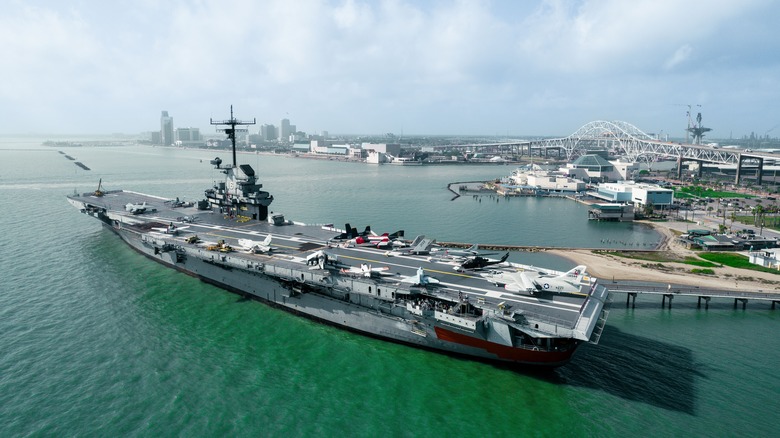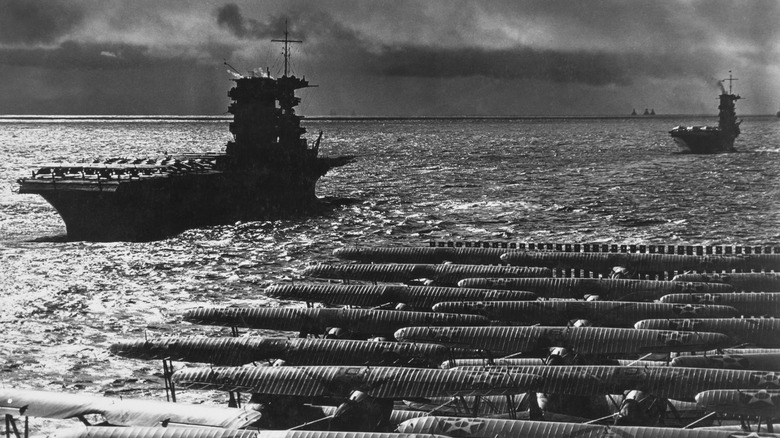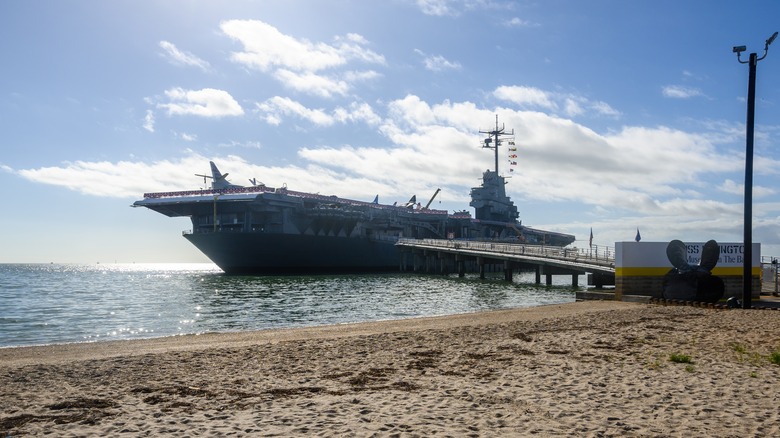What US Aircraft Carrier Turned Museum Is Docked In Corpus Christi, Texas?
The aircraft carriers employed by the United States Navy are truly works of engineering art. They're not just giant boats, they're entire traveling naval bases that are large enough to house thousands of soldiers and sailors and equipped with the technology to safely and efficiently launch all kinds of air vehicles. When you have a model of engineering on your hands like that, you put it to good use. Even if you have an aircraft carrier that's not actively engaging in maritime activities, it wouldn't be right to just let it rot in the ocean.
Such is the story of the oldest remaining Essex-class aircraft carrier, the USS Lexington. Originally created to fight in World War II, the USS Lexington was nearing the end of its operational rope in the late 1980s. Rather than scrap such a majestic vehicle for parts, a concentrated effort between naval forces and the city of Corpus Christi, Texas, resulted in the ship being permanently enshrined off the city's coast as a living museum of the United States' naval and aviation achievements, alongside similar museum vessels like the USS Intrepid and the USS Yorktown in New York and South Carolina, respectively.
The USS Lexington was originally commissioned in 1943
The USS Lexington was commissioned near the tail end of World War II in 1943. The vessel originally held the moniker of USS Cabot, but when another carrier with the name Lexington was sunk in the Coral Sea, the Cabot took up its mantle. Following training, the Lexington and its crew were deployed as part of the newly established Central Pacific Force at Pearl Harbor, also known simply as the Fifth Fleet.
The Lexington was in action for a total of 21 months, making appearances at every major naval conflict in the Pacific Theater. Some highlights from the Lexington's tenure include a raid on Kwajalein that destroyed a cargo ship and damaged two cruisers, a defensive operation against torpedo planes launched from Guam, and an airfield bombing run prior to the Iwo Jima landings.
On four separate occasions, propagandists for the Axis forces, particularly Japan, falsely reported that the Lexington had been sunk during conflicts. Obviously, this wasn't true, so when the ship would reappear in subsequent conflicts, Axis soldiers would be confused by its apparent rising from the dead. This earned the vessel the nickname "The Blue Ghost" from the Japanese Imperial Navy after its ocean blue camouflage.
The USS Lexington has functioned as a naval and aviation museum since 1992
Following the end of World War II, the Lexington was temporarily decommissioned, though it was reactivated in 1955 to serve as part of a defensive fleet during a period of heightened tension with Formosa, Laos, and Cuba. Once things cooled down there, the Lexington headed to Pensacola, Florida, in 1962 to serve as a naval training center.
The Lexington remained as a training center until the 1980s, when newer, more advanced ships began to join the naval ranks. It was starting to become costly to maintain the Lexington's outdated framework, and it seemed like the vessel was on its way toward the scrap heap. However, that was halted by a proposal from the residents of Corpus Christi, Texas. Urged by the city's longstanding support of the Navy, the Corpus Christi City Council approved a multi-million-dollar bond to bring the Lexington to the city's shores. The purchase was accepted, and in 1992, the Lexington was signed over in full to the city, where it was retooled and opened to the public as a naval museum.
The Lexington, now officially known as the USS Lexington Museum on the Bay, is alive and well to this day as both a museum and an officially designated National Historic Landmark. It maintains a regular rotation of exhibits about naval warfare, as well as some more modern amenities and attractions like escape rooms, a flight simulator, and even a 3D theater. The ship's upkeep and operation are funded entirely by grants, donations, admissions, and of course, gift shop sales.


